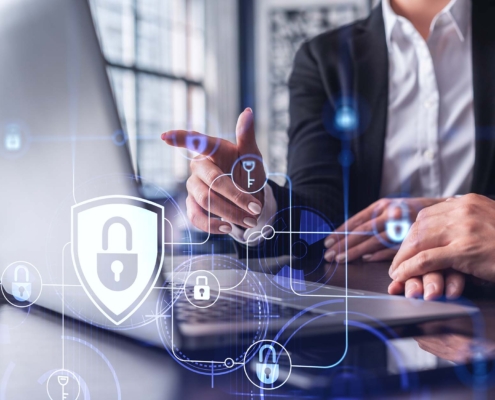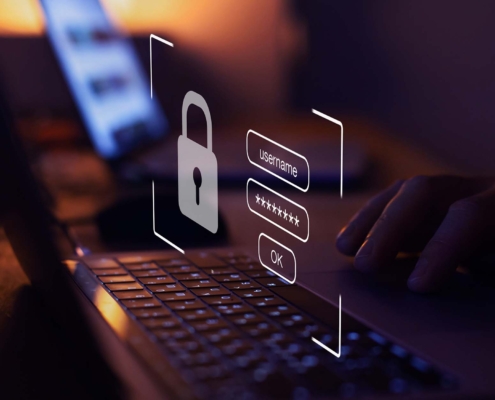 https://www.technologyresponse.com/wp-content/uploads/2024/08/Is-Your-Small-Business-at-Risk.jpg
1250
2000
Abstrakt Marketing
/wp-content/uploads/2024/06/logo-color.svg
Abstrakt Marketing2023-09-21 15:00:002025-04-26 07:30:18Assessing and Overcoming Small Business Cybersecurity Risks
https://www.technologyresponse.com/wp-content/uploads/2024/08/Is-Your-Small-Business-at-Risk.jpg
1250
2000
Abstrakt Marketing
/wp-content/uploads/2024/06/logo-color.svg
Abstrakt Marketing2023-09-21 15:00:002025-04-26 07:30:18Assessing and Overcoming Small Business Cybersecurity RisksRansomware is malicious software that encrypts a victim’s files. The attacker then demands a ransom from the victim to restore access to the data upon payment. Understanding how ransomware works and familiarizing oneself with effective ransomware prevention, detection, and recovery strategies is crucial for individuals and businesses of all sizes. In this article, we will explore the mechanics of ransomware attacks, discuss the fundamentals and advanced techniques of prevention ransomware detection strategies, and highlight effective recovery strategies in the unfortunate event of an attack.
What Is Ransomware? An Overview
Ransomware is a type of malware that prevents users from accessing their system or personal files and demands a ransom payment to regain access. It encrypts files on the victim’s computer or locks the system, making files, photos, and documents inaccessible. The earliest known ransomware attack happened in 1989. Today, ransomware is one of the most financially destructive malware threats.
There are several ransomware variants, including crypto-ransomware, which encrypts files; locker ransomware, which locks systems; mobile ransomware, which targets phones and tablets; and ransomware-as-service available on the dark web for conducting attacks.
How Does Ransomware Work?
Now that you have a better understanding of what it is, let’s examine how ransomware works:
The Mechanism of Ransomware Infections
Ransomware uses a multi-stage process to infect a system and encrypt files. This typically includes:
- Initial infection via social engineering, infected websites, and email attachments.
- Communication with command-and-control server to receive encryption key.
- Search for and encrypt files on local drives, network shares, and external storage.
- Prevent access to encrypted files and display ransom payment instructions.
Once installed, advanced ransomware also seeks out backup files, network drives, and connected systems to encrypt as much data as possible. Some ransomware also exfiltrates data before encrypting it for use in triple extortion attacks.
The Role of Encryption in Ransomware Attacks
The core mechanism of ransomware is strong encryption. Modern ransomware uses algorithms like AES, RSA, and Salsa20 to encrypt files. Many tactics are used, including deleting volume snapshots, tampering with Windows Shadow Copies, and using social engineering to get admin rights to encrypt core systems.
The encryption is designed to be unfeasible to crack without the decryption key held by the attackers. Even the FBI recommends not paying the ransom without other recovery options. Proactive measures like offline backups and updated endpoint security offer the best protection.
Ransomware Payment Methods
Early ransomware accepted ransom payments through prepaid voucher services. However, most modern ransomware demands payment in cryptocurrency, primarily Bitcoin. This provides anonymity to attackers collecting payments.
Many ransomware groups operate Ransomware-as-a-Service (RaaS) models and split proceeds between the affiliate conducting the attack and the overall operation. Payment is extremely risky and not recommended, but it can be the only option for retrieving stolen, encrypted data.
Ransomware attacks are just one of the many cybersecurity threats businesses face today. Learn more about other risks you must assess and overcome as a small business.
Understanding Ransomware Prevention Strategies
Now let’s look at different ways to protect against ransomware and avoid losing your sensitive data or other business-critical information:
Basic Prevention Measures
Some basic measures can help prevent ransomware attacks or minimize their impact. These include:
- Employee security awareness training to identify suspicious emails or links.
- Installing reputable endpoint security software with updated signatures.
- Regularly patching and updating all software, especially operating systems.
- Restricting software installation privileges for employees.
Blocking access to known malicious websites.
Promoting a security culture and enabling employees to identify risks is crucial to avoiding infections. Technical controls like antimalware software and firewalls provide additional protection against threats.
Implementing Advanced Cybersecurity Measures
Antivirus, antimalware, and next-gen endpoint detection software help block known threats and suspicious activity. Enable cloud-delivered protection and managed threat intelligence to stay updated on emerging attacks. Restrict admin privileges to prevent malware from thoroughly infecting systems.
Network segmentation and micro-segmentation limit lateral movement across systems if an attack occurs. Multi-factor authentication adds another layer of access control. Disable macros, limit write privileges and implement minor privilege policies to reduce the attack surface.
Backups provide redundancy in case of encryption by ransomware. Maintain offline, immutable backups, test restores regularly, and ensure versioning. Cloud backups facilitate recovery at scale if on-premises backups are impacted.
Importance of Employee Training in Preventing Phishing Attacks
Many ransomware attacks start with a phishing email to gain initial access. Security awareness training helps employees identify social engineering techniques, unsafe attachments, suspicious links, and other warning signs of phishing.
Educate staff to hover over links before clicking, double-check sender addresses, report suspicious messages, and avoid opening attachments from unknown sources. Simulated phishing tests reinforce secure habits. Ongoing training is essential as techniques evolve.
Establishing a human firewall through education is a powerful ransomware deterrent. Experts emphasize continuously updating staff skills to recognize the ever-changing methods of cyber criminals.
Importance of Regular Software Updates
One of the most essential ransomware prevention tactics is regularly updating and patching software. Ransomware exploits known software vulnerabilities to gain a foothold before deploying the malicious encryption payload.
Timely updates to operating systems, applications, browser plug-ins, frameworks, and APIs are critical. Automated patch management using tools like Microsoft WSUS or third-party solutions can simplify updates for endpoints and servers.
The Role of Antimalware Software in Preventing Ransomware
Advanced antimalware utilizes signatures, heuristics, and machine learning to block malware, offering real-time monitoring and quarantine. Next-gen endpoint detection and response (EDR) solutions enhance security with deep system visibility and threat intelligence, swiftly identifying and containing threats. Coupled with security training and layered cybersecurity defenses, these measures offer robust protection against evolving ransomware attacks on businesses.
Ransomware Detection: Identifying a Cyberattack
Let’s explore ransomware detection strategies to help you quickly identify an attack:
Common Signs of a Ransomware Attack
Detecting a ransomware attack quickly is critical to limit damage. Warning signs include slower system performance, crashes, unexplained file changes, inability to access data, and ransom notes or popups.
Users may experience locked screens preventing login. Antivirus software may alert suspicious file encryption in progress. Unexpected network disruptions and connection failures can signal an attack. Advanced endpoint detection tools using AI can automatically recognize telltale indicators of compromise and behavior analytics indicative of ransomware.
Slower System Performance: Noticing The Unusual
Ransomware encrypting files in the background can significantly reduce application and network responsiveness. Uncharacteristic lag times opening files or accessing servers warrant investigation.
While impacts vary by strain, ransomware notably interrupts average speeds. Savvy users will find performance issues trigger detection before serious encryption occurs. IT teams should monitor systems for anomalies. Sudden slowdowns rarely have benign causes—experts emphasize investigating responsiveness changes as a ransomware early warning.
Understanding Unwanted System Modification
Successful ransomware alters systems to allow those with malicious intent to gain access and encrypt data. Warning signs include unexpected application closures, crashed services, renamed or deleted files, and new unknown processes.
Antivirus alerts on blocked malware installations provide another opportunity to isolate systems and prevent encryption. Unexpected reboots or shutdowns could signal ransomware routines executing. IT specialists stress paying attention to unexplained or suspicious system changes as they often signify ransomware activity.
Role of IT Specialists in Ransomware Detection
IT teams are vital for detecting potential ransomware attacks through centralized monitoring and expert threat analysis. Security operations centers leverage powerful analytics tools combining anomaly detection, threat intelligence feeds, and behavioral sensors.
Monitoring infrastructure logs and endpoints for unusual activity provides ransomware alerts. Digital forensics can identify indicators of compromise and determine attack timelines. Specialists emphasize rapid isolation and mitigation before significant encryption spreads.
IT oversees technologies and processes enabling early ransomware identification, limiting potential business disruption.
Ransomware Recovery Strategies After an Attack
No matter what type of ransomware attack you face, a recovery strategy is crucial. Let’s explore some proven ransomware recovery techniques that can help minimize business disruptions:
Dealing With a Ransomware Attack
Despite best efforts, ransomware may still occur. Response plans activate containment protocols like disconnecting infected systems to prevent lateral movement.
IT teams restore encrypted data from clean backups and scan remaining systems for compromise. Law enforcement may investigate the attack if desired by the organization.
Experts do not recommend paying ransoms since payments incentivize criminals without guaranteeing decryption. Organizations should focus efforts on recovery via backups.
Importance of Immediate Isolation
Quickly isolating infected systems limits ransomware’s reach. Segmented networks facilitate isolating only compromised areas. Disconnecting infected devices can stop malware propagation.
Security teams must rapidly identify ground zero and logically or physically separate affected systems, advised experts. This stems from encryption and damage, beginning recovery. Prompt isolation and containment are imperative for enterprises to maintain business function when experiencing a ransomware attack.
Reporting a Cyberattack and Dealing with Data Breach Disclosure
Organizations have ethical and legal obligations regarding data breach disclosure if a ransomware attack impacts customer information.
Notify affected individuals and regulatory agencies per data protection laws. Fines may apply for failure to report. Transparent communication maintains trust. Cyber insurance may offset costs associated with reporting, customer alerts, and engaging forensic firms to investigate an attack’s scope.
Role of Backups in Data Recovery
Data backups enable restoring encrypted data without paying ransoms. Maintain regularly updated backups offline and immutable to resist attack.
Cloud backups provide scalable restoration after a ransomware incident. Test restores often to verify backup integrity and exercise recovery plans. Dependable backups are fundamental to restoring operational capability following an attack. Cyber insurance assists with data recovery expenses.
Need to Protect Your Business? Technology Response Team Knows How Ransomware Works
TRT specializes in ransomware protection for businesses in the Denver area. We do this by integrating robust cybersecurity defenses designed to ensure ransomware prevention, detection, and recovery. Don’t let cybercriminals hold your business hostage until a ransom is paid; contact us today to discuss your security needs and begin developing a plan.
Share This Post
More Like This
 https://www.technologyresponse.com/wp-content/uploads/2024/08/Is-Your-Small-Business-at-Risk.jpg
1250
2000
Abstrakt Marketing
/wp-content/uploads/2024/06/logo-color.svg
Abstrakt Marketing2023-09-21 15:00:002025-04-26 07:30:18Assessing and Overcoming Small Business Cybersecurity Risks
https://www.technologyresponse.com/wp-content/uploads/2024/08/Is-Your-Small-Business-at-Risk.jpg
1250
2000
Abstrakt Marketing
/wp-content/uploads/2024/06/logo-color.svg
Abstrakt Marketing2023-09-21 15:00:002025-04-26 07:30:18Assessing and Overcoming Small Business Cybersecurity Risks https://www.technologyresponse.com/wp-content/uploads/2024/08/Digital-cybersecurity-and-network-protection.jpg
1250
2000
Nate Riggins
/wp-content/uploads/2024/06/logo-color.svg
Nate Riggins2022-11-24 16:00:412025-04-26 07:30:19October Is Cybersecurity Awareness Month
https://www.technologyresponse.com/wp-content/uploads/2024/08/Digital-cybersecurity-and-network-protection.jpg
1250
2000
Nate Riggins
/wp-content/uploads/2024/06/logo-color.svg
Nate Riggins2022-11-24 16:00:412025-04-26 07:30:19October Is Cybersecurity Awareness Month https://www.technologyresponse.com/wp-content/uploads/2024/08/Is-Your-Small-Business-Prepared_.jpg
1250
2000
Nate Riggins
/wp-content/uploads/2024/06/logo-color.svg
Nate Riggins2022-10-18 15:00:002025-04-26 07:30:20Signs It’s Time To Upgrade IT Services
https://www.technologyresponse.com/wp-content/uploads/2024/08/Is-Your-Small-Business-Prepared_.jpg
1250
2000
Nate Riggins
/wp-content/uploads/2024/06/logo-color.svg
Nate Riggins2022-10-18 15:00:002025-04-26 07:30:20Signs It’s Time To Upgrade IT Services https://www.technologyresponse.com/wp-content/uploads/2024/08/Is-Your-Small-Business-Prepared_.jpg
1250
2000
Nate Riggins
/wp-content/uploads/2024/06/logo-color.svg
Nate Riggins2022-09-26 15:00:002025-04-26 07:30:20A Guide to Cybersecurity for Small Businesses
https://www.technologyresponse.com/wp-content/uploads/2024/08/Is-Your-Small-Business-Prepared_.jpg
1250
2000
Nate Riggins
/wp-content/uploads/2024/06/logo-color.svg
Nate Riggins2022-09-26 15:00:002025-04-26 07:30:20A Guide to Cybersecurity for Small Businesses https://www.technologyresponse.com/wp-content/uploads/2024/08/Is-Penetration-Testing-Essential.jpg
1250
2000
Nate Riggins
/wp-content/uploads/2024/06/logo-color.svg
Nate Riggins2022-09-22 15:00:002025-04-26 07:30:20How Important Is Network Penetration Testing?
https://www.technologyresponse.com/wp-content/uploads/2024/08/Is-Penetration-Testing-Essential.jpg
1250
2000
Nate Riggins
/wp-content/uploads/2024/06/logo-color.svg
Nate Riggins2022-09-22 15:00:002025-04-26 07:30:20How Important Is Network Penetration Testing? https://www.technologyresponse.com/wp-content/uploads/2024/08/PErson-Typing-Login-Information-on-Laptop.jpg
1250
2000
Nate Riggins
/wp-content/uploads/2024/06/logo-color.svg
Nate Riggins2022-07-20 03:00:002025-04-26 07:30:21How Cybersecurity Has Changed
https://www.technologyresponse.com/wp-content/uploads/2024/08/PErson-Typing-Login-Information-on-Laptop.jpg
1250
2000
Nate Riggins
/wp-content/uploads/2024/06/logo-color.svg
Nate Riggins2022-07-20 03:00:002025-04-26 07:30:21How Cybersecurity Has Changed https://www.technologyresponse.com/wp-content/uploads/2024/08/April-Blog-2-Image.jpg
1250
2000
Nate Riggins
/wp-content/uploads/2024/06/logo-color.svg
Nate Riggins2022-05-19 15:00:002025-04-26 07:30:21What Is Penetration Testing?
https://www.technologyresponse.com/wp-content/uploads/2024/08/April-Blog-2-Image.jpg
1250
2000
Nate Riggins
/wp-content/uploads/2024/06/logo-color.svg
Nate Riggins2022-05-19 15:00:002025-04-26 07:30:21What Is Penetration Testing? https://www.technologyresponse.com/wp-content/uploads/2024/08/2021April23Security_A_PH-ASa9KY.jpeg
300
900
Nate Riggins
/wp-content/uploads/2024/06/logo-color.svg
Nate Riggins2021-04-23 21:00:122025-04-26 07:30:21Protect your Facebook and Twitter from hackers
https://www.technologyresponse.com/wp-content/uploads/2024/08/2021April23Security_A_PH-ASa9KY.jpeg
300
900
Nate Riggins
/wp-content/uploads/2024/06/logo-color.svg
Nate Riggins2021-04-23 21:00:122025-04-26 07:30:21Protect your Facebook and Twitter from hackers https://www.technologyresponse.com/wp-content/uploads/2024/08/2021March31Security_A_PH-yXGGc3.jpeg
300
900
Nate Riggins
/wp-content/uploads/2024/06/logo-color.svg
Nate Riggins2021-03-31 21:00:002025-04-26 07:30:225 Ways systems can be breached
https://www.technologyresponse.com/wp-content/uploads/2024/08/2021March31Security_A_PH-yXGGc3.jpeg
300
900
Nate Riggins
/wp-content/uploads/2024/06/logo-color.svg
Nate Riggins2021-03-31 21:00:002025-04-26 07:30:225 Ways systems can be breachedAbout Us
Technology Response Team delivers comprehensive IT and cybersecurity solutions for nationwide businesses with locations in Denver and Louisville.

